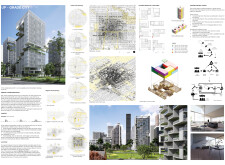5 key facts about this project
The design of "UP - GRADE CITY" focuses on creating a multifaceted urban environment that supports diverse lifestyles. Its architectural composition includes various building typologies, such as residential towers and slabs, allowing for a dynamic urban landscape. The project emphasizes modularity, ensuring that housing units can adapt to evolving needs over time. This flexibility is pivotal in promoting long-term sustainability, allowing for gradual changes without compromising the integrity of the community.
Central to the project's identity is its commitment to sustainability. The use of materials, including reinforced concrete for structural stability, extensive glass facades for natural lighting, and green roof systems for environmental benefits, reflects a thoughtful selection aimed at reducing the ecological footprint. Furthermore, the incorporation of renewable energy sources, like solar panels, enhances the energy efficiency of the buildings, making them more self-sufficient.
"UP - GRADE CITY" places significant importance on public spaces, fostering a sense of community among its residents. Parks, plazas, and community hubs are strategically interspersed throughout the development, promoting social interaction and outdoor activities. This integration of communal spaces is crucial for building relationships within the community, allowing residents to connect and engage in a shared environment. The layout of pedestrian pathways and cycling routes further enhances accessibility, encouraging active transportation methods that reduce reliance on vehicles.
One of the most notable aspects of the design is its innovative approach to housing finance and community involvement. By employing a hybrid funding strategy that includes community contributions and investment, "UP - GRADE CITY" aims to create an inclusive housing market. This model not only addresses affordability but also empowers residents by involving them in the decision-making process. Housing units are designed to allow for customization, catering to the diverse demographics and family structures within the community.
The project also strategically responds to its surrounding context, integrating seamlessly with the existing urban grid and enhancing connectivity. The proximity to the Eglinton Light Rail Transit (LRT) route is a significant factor that informs both the planning and design elements, promoting transit-oriented development that encourages sustainable transportation options.
"UP - GRADE CITY" stands as a model of modern architecture that prioritizes thoughtful design and social equity. Its unique features, such as modular housing, community-centric planning, and a focus on environmental sustainability, set it apart as a forward-thinking solution in the realm of urban development. Readers interested in exploring this project further are encouraged to review the architectural plans, sections, and designs for a more in-depth understanding of the concepts and ideas that inform this compelling urban initiative. This project represents an opportunity for innovation in enhancing urban living, making it a significant contribution to the discourse on contemporary architecture and urban planning.























